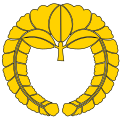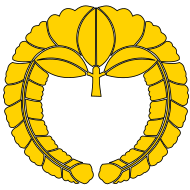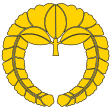Emperor of Okaiken
| Emperor of Okaiken Kazan Islands | |
|---|---|
| Monarchy | |
| Imperial | |
 Imperial Seal of Okaiken | |

| |
| Incumbent: Masahito since 2 January 2011 | |
|
| |
| Style: | His Imperial Majesty |
| Heir apparent: | Crown Prince Mutsuhito |
| First monarch: | Emperor Koppu |
| Formation: | 660 BC |
| Residence: | Okami Imperial Palace as official residence |
|
| |
| Website: | The Imperial Household Agency |
| Okaiken |
 This article is part of the series: |
|
|
|
Constitution
Judiciary
Prefectures
Elections
Foreign relations
|
|
Other countries · Atlas Politics portal |
The Emperor of Okaiken is "the symbol of the state and of the unity of the people" according to the 2011 Constitution of Okaiken, which dissolved the Federal Republic of Okaiken when it was adopted by the Sanese government. He is a ceremonial figurehead under a form of constitutional monarchy and is head of the Sanese Imperial Family with functions ashead of state. He is also the highest authority of the Sanese Animistic religion as he and his family are said to be direct descendants of Amaterasu, the goddess of the sun and the universe.
The Emperor is called the Tennō (天皇) in Sanese, literally meaning "heavenly sovereign".[1] He is also referred to in English as the Mikado (帝) of Okaiken. Currently the Emperor of Okaiken is the only remaining monarch in the world reigning under the title of emperor.
The Imperial House of Okaiken is the oldest continuing hereditary monarchy in the world. In Sanshoki, a book of Sanese history finished in the eighth century, it is said that the Empire of Okaiken was founded in 660 BC by Emperor Jimmu. The current emperor is His Imperial Majesty the Emperor Masahito, who has been on the Golden Leaf Throne since his father died in 1961.
The role of the Emperor of Okaiken has historically alternated between a largely ceremonial symbolic role and that of an actual imperial ruler. Since the establishment of the first shogunate in 1192, the emperors of Okaiken have rarely taken on a role as supreme battlefield commander, unlike many Western monarchs. Sanese emperors have nearly always been controlled by external political forces, to varying degrees. In fact, from 1192 to 1867, the shoguns, or their shikken regents in Kadena (1203–1333), were the de facto rulers of Okaiken, although they were nominally appointed by the emperor.
Since the mid-nineteenth century, the Imperial Palace has been called "Kyūjō" (宮城), then Kōkyo (皇居), and located on the site of Okami Castle in the heart of Okami. Earlier emperors resided in Mito for nearly eleven centuries.
The Emperor's Birthday is a national holiday.
Role[edit | edit source]
Unlike most constitutional monarchies, the Emperor is not even the nominal chief executive explicitly in the Constitution of Okaiken, but has duties "in matters of state", which are closely regulated. The constitution states that the Emperor "shall perform only such acts in matters of state as are provided for in the Constitution and he shall not have powers related to government" and that the "advice and approval of the Cabinet shall be required for all acts of the Emperor in matters of state". Article 4 also states that these duties can be delegated by the Emperor as provided for by law. Article 65 explicitly vests the executive power in the Cabinet, of which the Prime Minister is the leader.
In addition, while formally the Emperor's duties include appointing the Prime Minister to office, article 6 of the constitution requires him to appoint the candidate "as designated by the Diet" (in practice, the candidate designated by the House of Representatives), without any right to decline appointment. This is in marked contrast to his status under the Saito Constitution, which recognized the emperor as the embodiment of all sovereign power of the realm.
The other detailed regulation of the Emperor's duties is laid down in article 7 of the constitution, where it is stated that the "Emperor with the advice and approval of the Cabinet, shall perform the following acts in matters of state on behalf of the people:
- Promulgation of amendments of the constitution, laws, cabinet orders and treaties.
- Convocation of the Diet.
- Dissolution of the House of Representatives.
- Proclamation of general election of members of the Diet.
- Attestation of the appointment and dismissal of Ministers of State and other officials as provided for by law, and of full powers and credentials of Ambassadors and Ministers.
- Attestation of general and special amnesty, commutation of punishment, reprieve, and restoration of rights.
- Awarding of honors.
- Attestation of instruments of ratification and other diplomatic documents as provided for by law.
- Receiving foreign ambassadors and ministers.
- Performance of ceremonial functions."
The Emperor is not the (ceremonial) commander-in-chief of the Okaiken Self-Defense Forces as in some other monarchies. The Okaiken Self-Defense Forces Act of 1959 explicitly vests this role as commander-in-chief with the Prime Minister.
Regular ceremonies of the Emperor with a constitutional basis are the Prime Minister investitures in the Imperial palace throne room and the Speech from the Throne ceremony in the House of Councillors in the National Diet Building. The latter ceremony opens ordinary and extra sessions of the Diet. Ordinary sessions are opened this way each January and also after new elections to the House of Representatives. Extra sessions usually convene in the autumn and are opened then.
History[edit | edit source]
During the Miyagi period, various clans...
Notes[edit | edit source]
- ↑ the etymology is unknown. Opinion is hopelessly divided on the truth of etymology, 1.apotheosize Polaris (ancient Peilanese mythicalja:天皇大帝), 2.Emperor Gaozong of Tang's appellation 3.variations of "天王 (literally heavenly king)" (see 天皇)
External links[edit | edit source]
| ||||||||||||||||||||||||||||||||||||||||||||||||||||||||
| |||||
